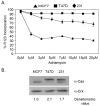A novel association between p130Cas and resistance to the chemotherapeutic drug adriamycin in human breast cancer cells
- PMID: 18974122
- PMCID: PMC2597570
- DOI: 10.1158/0008-5472.CAN-08-2426
A novel association between p130Cas and resistance to the chemotherapeutic drug adriamycin in human breast cancer cells
Abstract
Resistance to chemotherapy remains a major obstacle for the treatment of breast cancer. Understanding the molecular mechanism(s) of resistance is crucial for the development of new effective therapies to treat this disease. This study examines the putative role of p130(Cas) (Cas) in resistance to the cytotoxic agent Adriamycin. High expression of Cas in primary breast tumors is associated with the failure to respond to the antiestrogen tamoxifen and poor prognosis, highlighting the potential clinical importance of this molecule. Here, we show a novel association between Cas and resistance to Adriamycin. We show that Cas overexpression renders MCF-7 breast cancer cells less sensitive to the growth inhibitory and proapoptotic effects of Adriamycin. The catalytic activity of the nonreceptor tyrosine kinase c-Src, but not the epidermal growth factor receptor, is critical for Cas-mediated protection from Adriamycin-induced death. The phosphorylation of Akt and extracellular signal-regulated kinase 1/2 (ERK1/2) is elevated in Cas-overexpressing cells treated with Adriamycin, whereas expression of the proapoptotic protein Bak is decreased. Conversely, Cas depletion in the more resistant T47D and MDA-MB-231 cell lines increases sensitivity to Adriamycin. Based on these data, we propose that Cas activates growth and survival pathways regulated by c-Src, Akt, and ERK1/2 that lead to the inhibition of mitochondrial-mediated apoptosis in the presence of Adriamycin. Because Cas is frequently expressed at high levels in breast cancers, these findings raise the possibility of resensitizing Cas-overexpressing tumors to chemotherapy through perturbation of Cas signaling pathways.
Figures






Similar articles
-
CAS proteins in normal and pathological cell growth control.Cell Mol Life Sci. 2010 Apr;67(7):1025-48. doi: 10.1007/s00018-009-0213-1. Epub 2009 Nov 25. Cell Mol Life Sci. 2010. PMID: 19937461 Free PMC article. Review.
-
Expression of a phosphorylated p130(Cas) substrate domain attenuates the phosphatidylinositol 3-kinase/Akt survival pathway in tamoxifen resistant breast cancer cells.J Cell Biochem. 2009 May 15;107(2):364-75. doi: 10.1002/jcb.22136. J Cell Biochem. 2009. PMID: 19330798 Free PMC article.
-
Physical and functional interactions between Cas and c-Src induce tamoxifen resistance of breast cancer cells through pathways involving epidermal growth factor receptor and signal transducer and activator of transcription 5b.Cancer Res. 2006 Jul 15;66(14):7007-15. doi: 10.1158/0008-5472.CAN-05-3952. Cancer Res. 2006. PMID: 16849545
-
BCAR3 regulates Src/p130 Cas association, Src kinase activity, and breast cancer adhesion signaling.J Biol Chem. 2010 Jan 22;285(4):2309-17. doi: 10.1074/jbc.M109.046631. Epub 2009 Nov 23. J Biol Chem. 2010. PMID: 19940159 Free PMC article.
-
Inhibition of erbB receptor (HER) tyrosine kinases as a strategy to abrogate antiestrogen resistance in human breast cancer.Clin Cancer Res. 2001 Dec;7(12 Suppl):4436s-4442s; discussion 4411s-4412s. Clin Cancer Res. 2001. PMID: 11916237 Review.
Cited by
-
p130Cas/Cyclooxygenase-2 axis in the control of mesenchymal plasticity of breast cancer cells.Breast Cancer Res. 2012 Oct 26;14(5):R137. doi: 10.1186/bcr3342. Breast Cancer Res. 2012. PMID: 23098208 Free PMC article.
-
The interaction of p130Cas with PKN3 promotes malignant growth.Mol Oncol. 2019 Feb;13(2):264-289. doi: 10.1002/1878-0261.12401. Epub 2018 Dec 3. Mol Oncol. 2019. PMID: 30422386 Free PMC article.
-
Silencing of p130cas in ovarian carcinoma: a novel mechanism for tumor cell death.J Natl Cancer Inst. 2011 Nov 2;103(21):1596-612. doi: 10.1093/jnci/djr372. Epub 2011 Sep 28. J Natl Cancer Inst. 2011. PMID: 21957230 Free PMC article.
-
Noncanonical TGF-β signaling during mammary tumorigenesis.J Mammary Gland Biol Neoplasia. 2011 Jun;16(2):127-46. doi: 10.1007/s10911-011-9207-3. Epub 2011 Mar 31. J Mammary Gland Biol Neoplasia. 2011. PMID: 21448580 Free PMC article. Review.
-
CAS proteins in normal and pathological cell growth control.Cell Mol Life Sci. 2010 Apr;67(7):1025-48. doi: 10.1007/s00018-009-0213-1. Epub 2009 Nov 25. Cell Mol Life Sci. 2010. PMID: 19937461 Free PMC article. Review.
References
-
- Fleming G. Oncologic Therapies. 2nd edition Springer; Chicago: 2003.
-
- Faneyte IF, Kristel PM, Maliepaard M, et al. Expression of the breast cancer resistance protein in breast cancer. Clin Cancer Res. 2002;8:1068–74. - PubMed
-
- Walker J, Martin C, Callaghan R. Inhibition of P-glycoprotein function by XR9576 in a solid tumour model can restore anticancer drug efficacy. Eur J Cancer. 2004;40:594–605. - PubMed
-
- Ruiz de Almodovar C, Ruiz-Ruiz C, Munoz-Pinedo C, Robledo G, Lopez-Rivas A. The differential sensitivity of Bcl-2-overexpressing human breast tumor cells to TRAIL or doxorubicin-induced apoptosis is dependent on Bcl-2 protein levels. Oncogene. 2001;20:7128–33. - PubMed
-
- Gariboldi MB, Ravizza R, Riganti L, et al. Molecular determinants of intrinsic resistance to doxorubicin in human cancer cell lines. Int J Oncol. 2003;22:1057–64. - PubMed
Publication types
MeSH terms
Substances
Grants and funding
LinkOut - more resources
Full Text Sources
Medical
Research Materials
Miscellaneous

